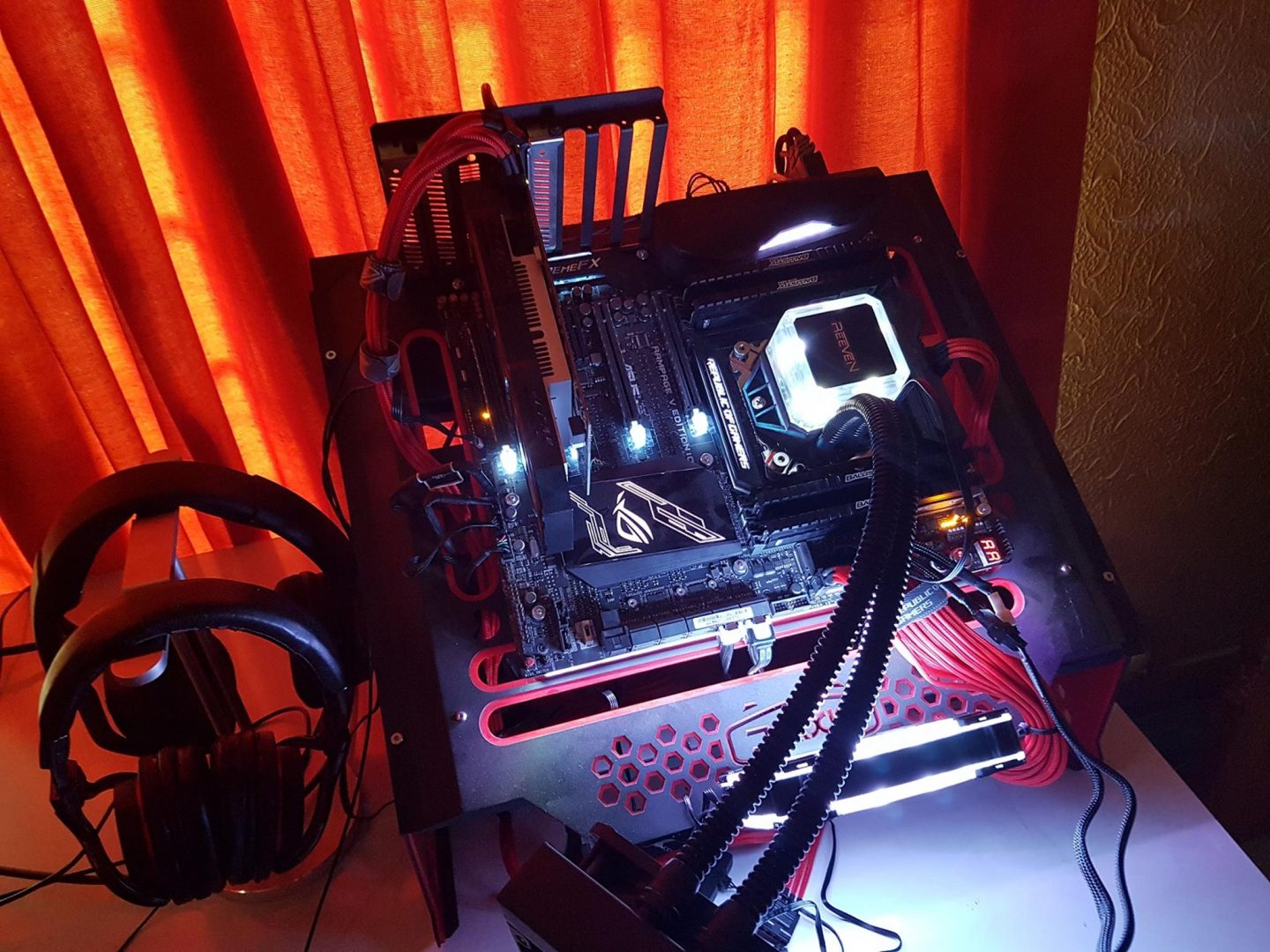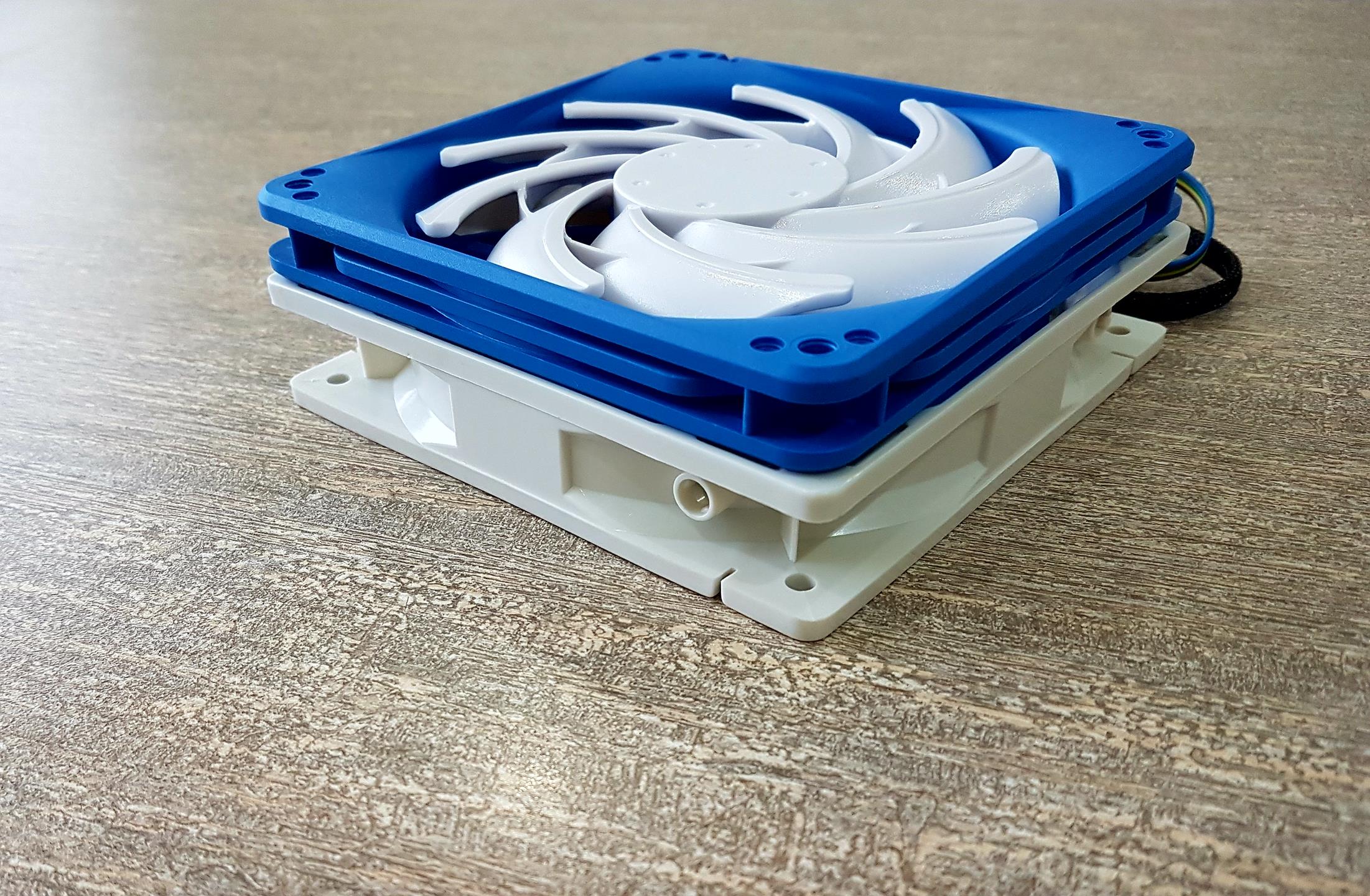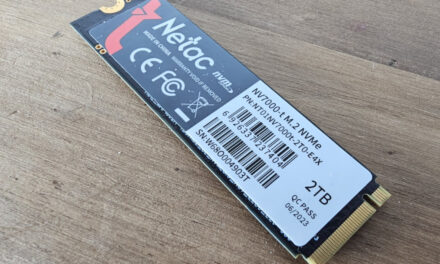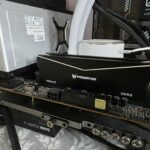
Polartherm X8 and X10 Thermal Pastes Review
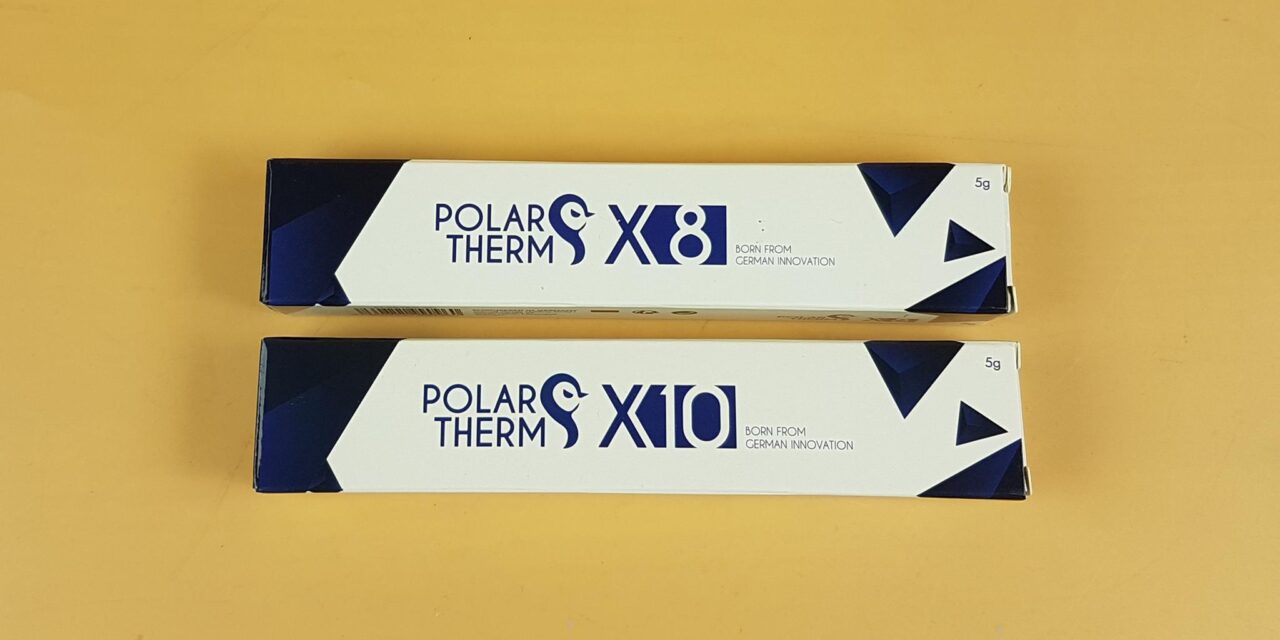
Thermal Paste or thermal compound or TIM (thermal interface material) as you may call it is a heat-conducting material that plays a crucial role in transferring heat from the heat source to the cooler. Why do we need this in the first place? Ideally, we want the perfect flat contacting surfaces (CPU/GPU and coolers).
However, this is not the case, particularly on the Intel SKUs, particularly the LGA1700 compatible CPUs which have concave layout. Not only that but there are micro gaps between the two contact surfaces that impede the heat transfer from one source to the other. Air fills these micro gaps and if you don’t know, air also has a thermal conductive rating which is usually around 0.026 to 0.03 W/mK. This is too low a value to effectively transfer heat from the CPU/GPU to the cooler.
This is why we need a solution that not only fills those micro gaps but also provides effective heat transfer between the contacting surfaces and this is where the thermal pastes come into playing its role. There are many types of these pastes including:
- Regular Silicone based Thermal Pastes
- Liquid Metal
- Phase Changing Thermal Pastes
- Thermal Pads
The market is filled with a lot of offers in the first category as this is the most mainstream option employed for heat transfer.
These thermal pastes have a thermal conductivity rating from over 2 to as high as 17 W/mK. If you want to go further, then liquid metals are your options with over 50W/mK thermal conductivity ratings. However, these are electrically conductive and can easily kill your CPU and/or motherboard.
When it comes to thermal pastes, there are many variables or factors that need to be accounted for. These include:
- Thermal Conductivity
- Thermal Resistance or Impedance
- Viscosity
- Specific Gravity
- Operating Temperature Range
Users tend to pay attention to one variable which is thermal conductivity. There is nothing in this kind of attention as we want the thermal paste with a higher value anyway. There are cases where the actual difference between a thermal paste of 16 W/mK may have a marginal gain over the thermal paste of 12 W/mK. The makeup of the thermal paste would determine the thermal conductivity. Paste with small particles tends to provide high or better thermal conductance compared to the pastes with large particles since these particles fill the micro gaps.
But we also want the thermal pastes with lower thermal resistance. Here thermal resistance may have a different understanding than the electrical resistance. Thermal resistance simply means the overall drop in temperature across the thermal paste interface. This is related to the thermal conductance and viscosity of the thermal paste.
Viscosity is a critical variable as it will give you a hint or idea about the longevity of the thermal paste and its related pump-out effect. Viscosity simply refers to how hard or soft, the material will be under the mounting pressure. Too soft or thin pastes may not have a long life under the mounting pressure as the thermal paste may dry out. Similarly, thermal pastes with high viscosity will be hard to apply. Low-viscosity thermal pastes would come in handy where the thermal load is not that significant like on Core i5s. As a general rule, a mediocre viscosity rating would do you fine.
Sorry for taking your time above. Let’s come back to the topic which is Polartherm. This is a new brand but it definitely needs no introduction since this is a sister brand of no other but Thermal Grizzly. Both brands are from Germany. While we all know what Thermal Grizzly offers, the Polartherm intends to provide cost-effective thermal pastes for the mainstream users. They have introduced X8 and X10 thermal pastes.
These pastes are available in multiple sizes. Data is:
| Capacity/Size | Price | Price per Gram |
| PT X8 – 2g | €2.90 $5.90 | €1.45 / $2.95 |
| PT X8 – 5g | €4.90 $7.90 | €0.98 / $1.58 |
| PT X8 – 10g | €8.90 $12.90 | €0.89 / $1.29 |
| PT X8 – 40g | €14.90 $19.90 | €0.37 / $0.49 |
| PT X10 – 2g | €3.90 $6.90 | €1.95 / $3.45 |
| PT X10 – 5g | €5.90 $8.90 | €1.18 / $1.78 |
| PT X10 – 10g | €9.90 $13.90 | €0.99 / $1.39 |
| PT X10 – 40g | €16.90 $25.90 | €0.42 / $0.64 |
US Dollar ($) pricing is taken from Amazon at the time of this writing. European pricing is provided by the manufacturer.
Specifications
| Polartherm X8 | PolarTherm X10 | |
| Color | Grey | Grey |
| Electrically Conductive | No | No |
| Density | 2.6 g/cm³ | 2.6 g/cm³ |
| Operating Temperature | -50ᵒC to 150ᵒC | -50ᵒC to 150ᵒC |
| Typical Applications | CPU/GPU/Notebook/IC | CPU/GPU/Notebook/IC |
| Recommended CPUs | Intel Core i3/i5 Intel Ultra 3/5 AMD Ryzen 3/5 | Intel Core i7/i9 Intel Ultra 7/9 AMD Ryzen 7/9 |
Closer Look
Here is what Polartherm says about its brand, “Polartherm thermal pastes are an affordable and high-quality alternative to the pastes often included with budget CPU coolers. In contrast to many low-performing stock thermal pastes typically included with cheaper coolers, Polartherm thermal pastes offer good conductivity and viscosity resulting in easy application, long-lasting durability, and pump-out effect resistance even in demanding conditions.”
This statement itself defines the target market for these thermal pastes. Polartherm is offering low-cost, good-performance thermal pastes to replace the thermal pastes bundled with budget CPU coolers.

We have got the 5gm packs of X8 and X10. These pastes are shipped in a tube. The main packing box is made of paperboard.
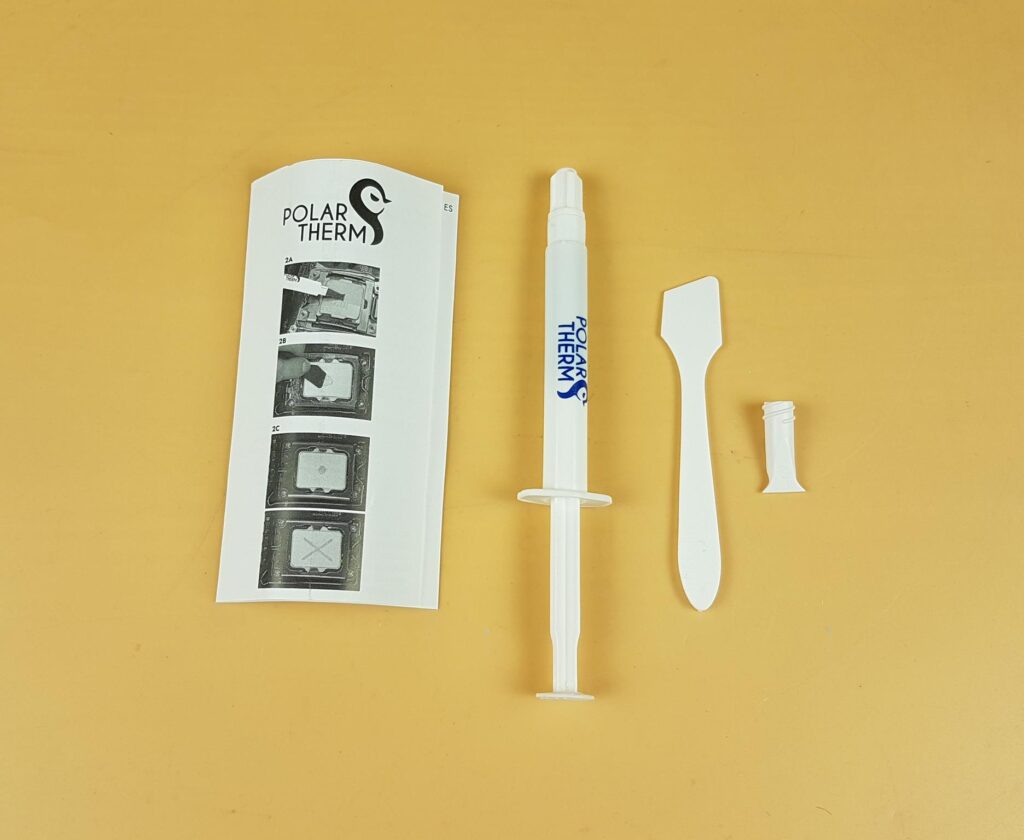
The above picture shows the total contents of a single box:
- A user guide
- 1 Tube
- 1x Spatulas
- 1x Thermal Paste Applicator
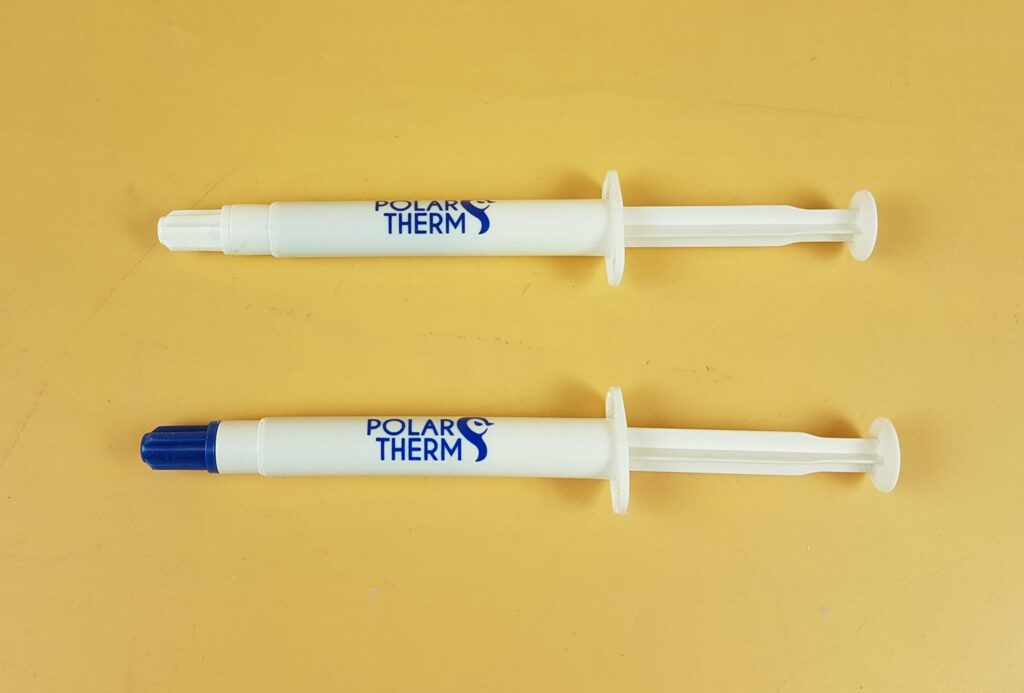
I am showing tubes of X8 and X10. There is no label on the tubes. Only Polartherm branding is printed over the label. How to distinguish between X8 and 10? The X8 tube has a white cap whereas the X10 tube has a blue cap.
The salient features of these thermal pastes are:
- designed for mainstream users
- no curing
- long-term durability
- non-electrically conductive
Both thermal pastes are silicone-based using a mixture of silicone oil-based carriers with a mixture of aluminum and zinc oxide powder. The exact strength of this mixture is not mentioned. Polartherm uses small-sized particles for effective heat dissipation. Compared to X8, the X10 has a high aluminum and zinc oxide mixture concentration, offering better thermal conductivity.
Both thermal pastes use a well-balanced formula and composition to resist the pump-out effect. The X8 has low viscosity whereas the X10 has high viscosity. This makes X8 suitable for CPUs that produce comparatively less thermal load whereas the X10 is designed for the CPUs that produce high or more thermal load.
Testing
Now coming to the main point of this article, the following configuration is used for thermal paste testing: –
- Intel i7 13700k
- MSI MEG Z790 ACE MAX
- XPG Lancer RGB 32GB @ 7200MHz CAS 34
- GIGABYTE GeForce RTX 3060 VISION OC [For Display]
- XPG Rocket 4 Plus 2TB NVMe SSD [For OS]
- Fractal Design ION+ 2P 860W PSU
- Thermaltake Core P6 TG Snow Edition in an open frame layout
- Alphacool Core 1 LT Aurora Black Water Block
- Alphacool Eisblock XPX Aurora Pro Water Block
- Alphacool NexXxoS HPE-45 Full Copper 420mm Radiator
- Alphacool Eisbecher Aurora D5 Acetal/Glass – 250mm
- Alphacool VPP APEX Pump
- Alphacool EPDM tube 16/10 Black
- Alphacool HF 16/10 screw-on nozzle 90° rotatable G1/4
- Alphacool HF 16/10 screw-on nozzle 45° rotatable G1/4
- Alphacool Eiszapfen 16/10mm screw-on nozzle
- Alphacool HF sleeve G1/4 female to G1/4 female
- Alphacool Eiszapfen quick release coupling set G1/4 AG
- Alphacool Eiszapfen temperature sensor G1/4
- Alphacool Core ATX 24-pin jumper plug
- Noctua NF-A14x25 G2 PWM Fans
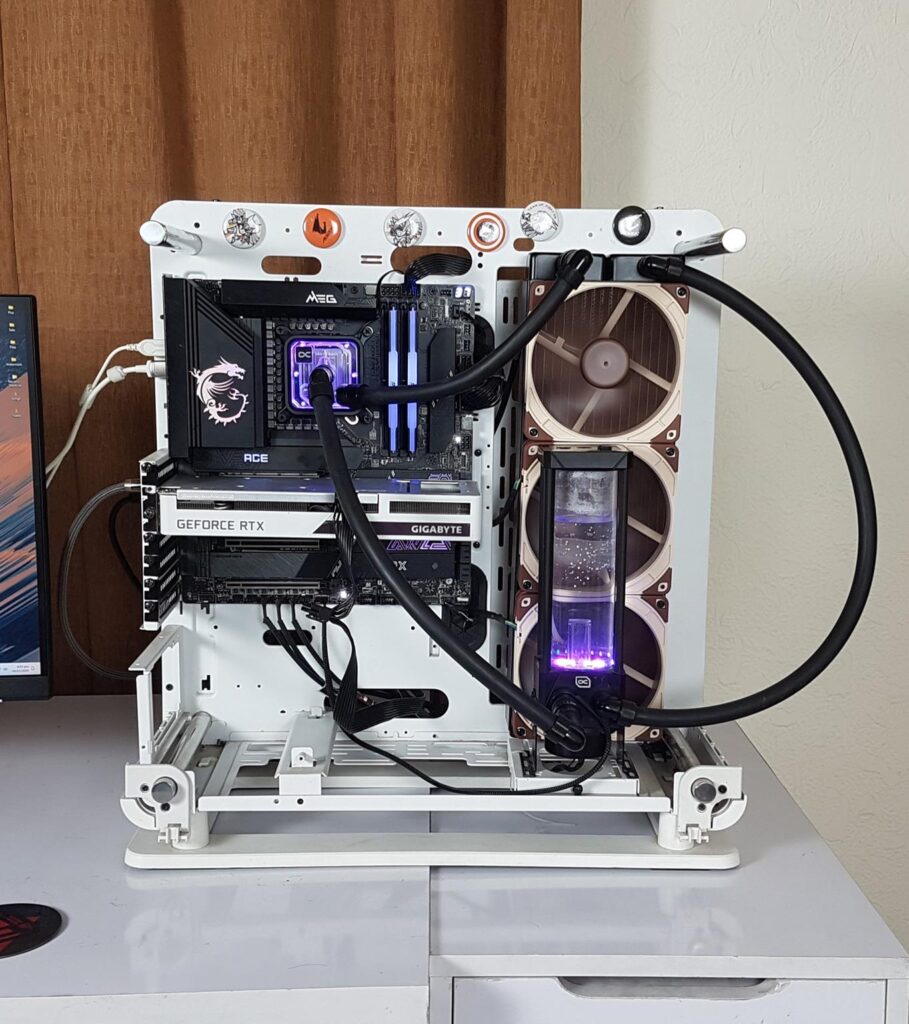
Since I was testing thermal pastes after some time hence included the following thermal pastes in this testing:
- ARCTIC MX6
- Noctua NT-H1
- DeepCool Z9
- Alseye T9+
- Gamdias XC5
- CORSAIR XTM50
- ID-Cooling Frost XT45
- Thermal Grizzly Kryonaut
- Halnziye HM-805
- Halnziye HY-P15
- Polartherm X8
- Polartherm X10
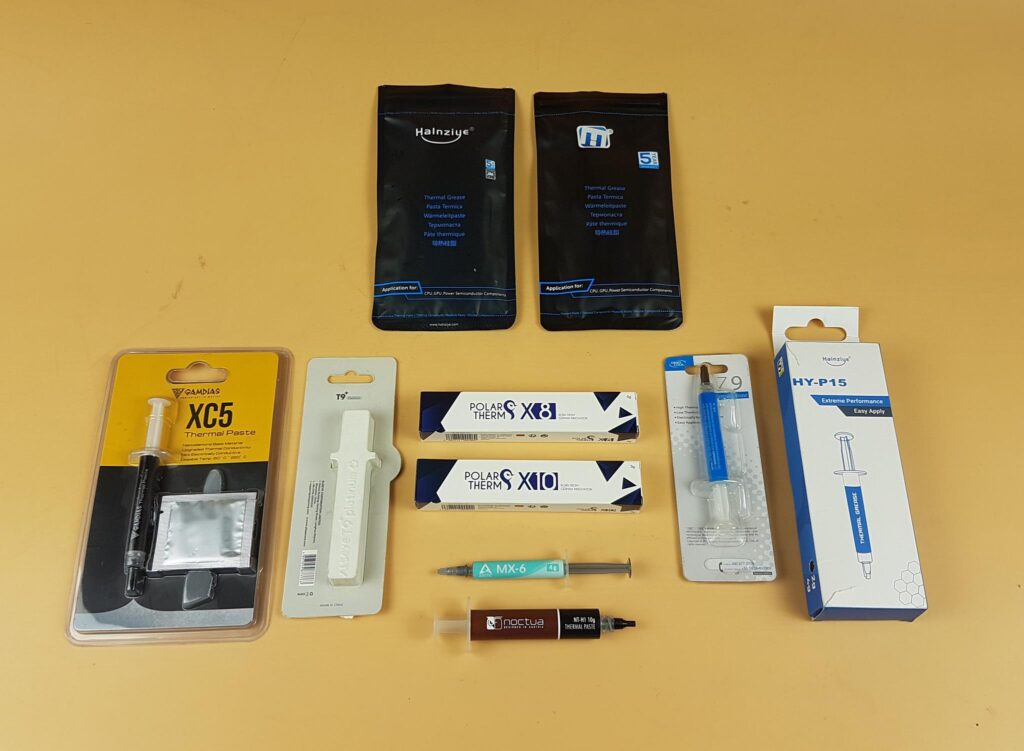
How we have tested?
The following testing methodology is used for the thermal paste testing:
- This CPU was overclocked with P-Cores at 5.6GHz at all cores and E-Cores 4.4GHz at all cores
- AVX Load was enabled with 0 offset
- Power limits were removed
- VCore was set to Adapative
- The package power draw was 270W
- Thermal Pastes were applied in an X shape.
- Since mounting pressure plays an important role, I stopped as soon as threads run out on each screw of the CPU water block.
- The reason for using a custom loop is that this CPU runs warm even on stock and takes nearly 1.40V despite BIOS updates. All other AIOs and air coolers have struggled and I needed results hence a powerful cooling solution was employed. The CPU was overclocked with AVX enabled to produce as much heat as possible.
- Ambient or Room temperature was in the range of 21.7ᵒ to 22.4ᵒC. Since thermal pastes strive for even decimals of degrees Celsius, I will also report the delta temperature along with the absolute temperature.
- At least one thermal cycle was completed before actual testing. This was done by powering the system and leaving it idle for a minimum of 5 minutes. Then a 10-minute run of Cinebench R23.2 was run followed by an idle state and then the system was powered off for 20 minutes. The actual test was made on the next power cycle.
- For testing, the PC was left on idle for 5 minutes.
- Cinebench R23.2 run was made to put the load on the CPU.
- An average of three test runs is made.
- CPU Package Temperature is taken as a reporting value to represent the worst-case scenario.
- The fans and pump were running at full speed (100% PWM duty cycle).
- HWInfo64 was used to monitor the sensors.
Please note that not every run of the stress test may yield the same result. This could well be due to many factors like mounting pressure, thermal paste application, and varying ambient temperature. Not to mention the silicon differences even among the same category of the chips. Hence, it is pertinent to mention the testing methodology along with the specifics.
Let’s take a look at the results.
Result
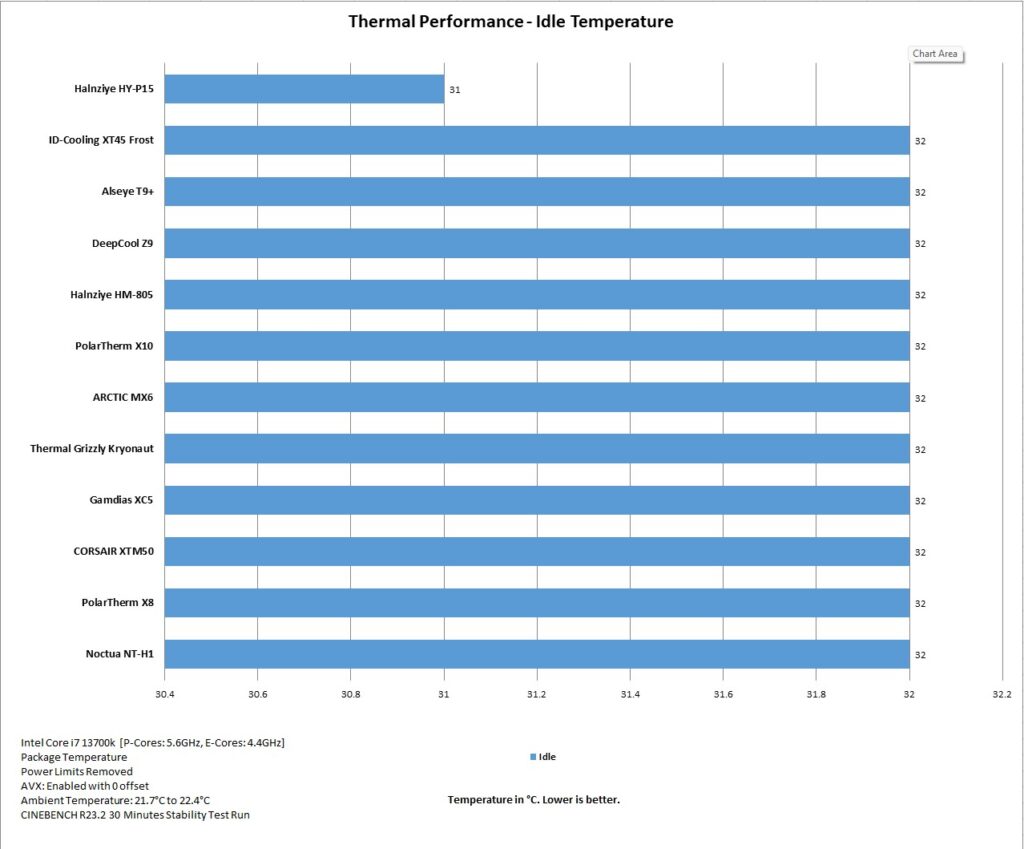
Idle temperature was 32ᵒC across the board except that of Halnziye HY-P15 thermal paste which did 31ᵒC. Idle temperatures are fine and not telling us anything.
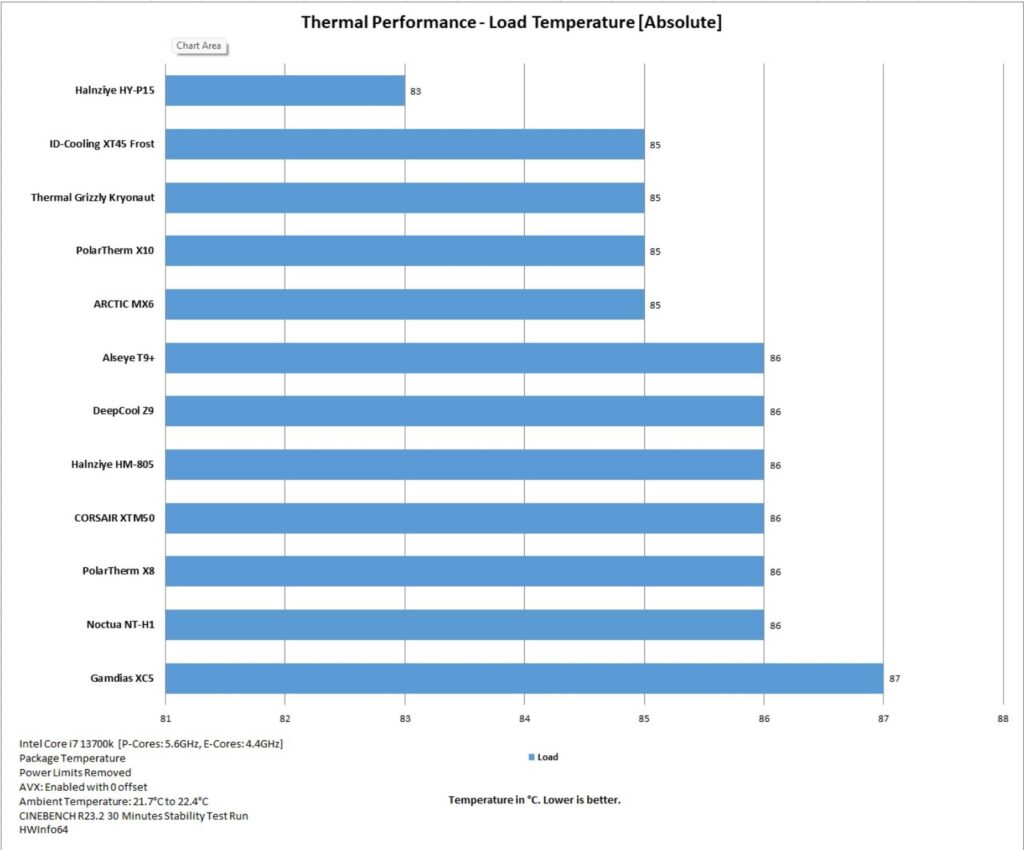
Now, I am showing the absolute temperature of the CPU in the testing using all thermal pastes. The main reason for this is that the variation of room/ambient temperature was less than 1ᵒC throughout the testing.
You can see that Halnziye HY-P15 is sitting on the top with 83ᵒC. This thermal paste has a thermal conductivity rating of 15.2 W/mK and its low cost is the reason, I have included this thermal paste in the comparison.
Polartherm X10 offers a good performance comparable to some high-performance thermal pastes like Thermal Grizzly Kryonaut, ARCTIC MX-6, and ID-Cooling Frost XT-45. This equation favors the Polartherm X10 since the per gram price of this thermal paste is highly competitive and gives a better value for your bucks. Plus this paste is easy to apply and manage.
On the other hand, the Polartherm X8 has also shown its supremacy by remaining highly competitive in the mainstream segment while offering a better value than many of the listed thermal pastes.
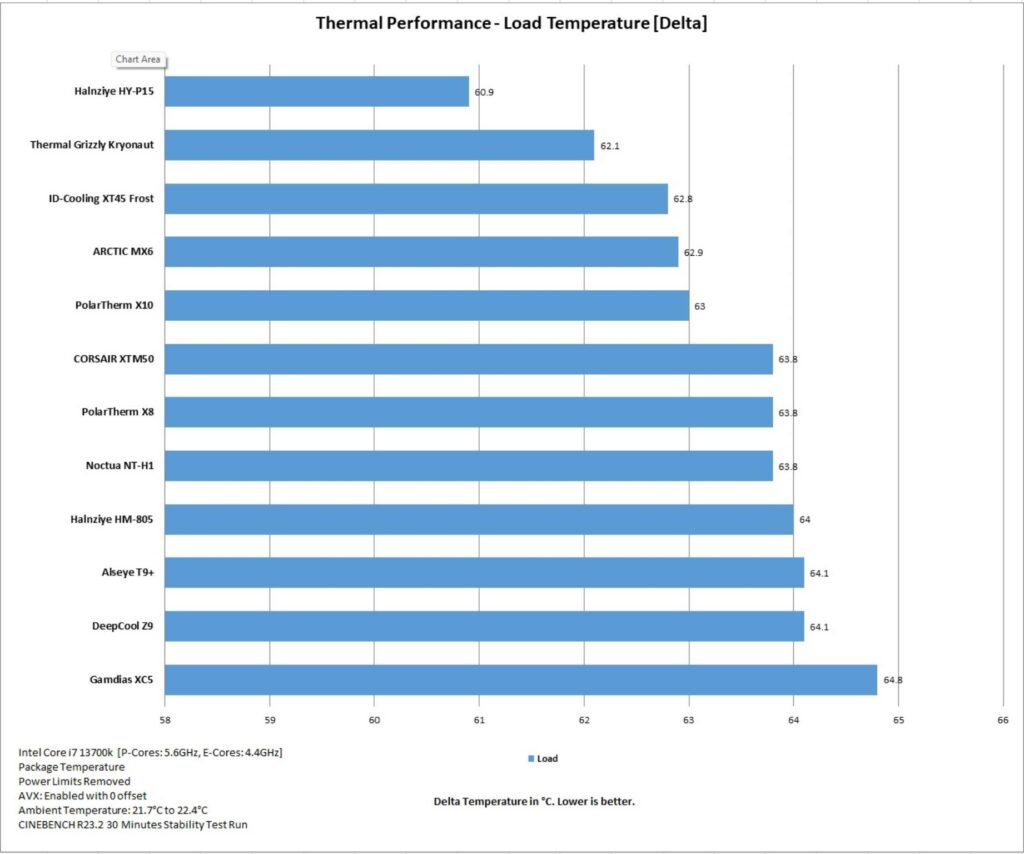
Since the variation among these thermal pastes is narrow, it would be a good idea to look at the delta values and see how these actually fare. You can see that Polartherm X10 and X8 are still competitive and their relatively low price tag offers a better value.
Conclusion
In a somewhat surprising move, Thermal Grizzly has launched a sister brand named Polartherm. This brand offers thermal pastes namely X8 and X10. The main objective is to provide high-performance thermal pastes costing less. This means they are aiming at the mainstream market segment.
The main thermal paste from Thermal Grizzly has been Kryonaut for some time now. It is a high-performance thermal paste that is not cheaper. Kryonaut Extreme is a different breed and is best suited for overclockers and LN applications. This move of launching cost-effective good performing thermal pastes could indicate that a new flagship thermal paste from Thermal Grizzly is on the horizon. Who knows! Time will tell.
We got the X8 and X10 thermal pastes and took a spin on both. Both pastes have a gray color. They are made of silicone oil-based carriers with a mixture of aluminum and zinc oxide. The X10 has a high concentration of this mixture, unlike the X8. Similarl,y X8 has low viscosity making it suitable for the load thermal load CPUs whereas X01 with its higher viscosity is suited for high thermal load CPUs.
Both thermal pastes actually have a well-balanced formula and they are super easy to apply unlike the Kryonaut or Kryonaut Extreme although users can still sock the Kryonaut paste tube in a cup of warm water for easy application. The operating temperature range of these pastes is -50ᵒC to 150ᵒC. These thermal pastes don’t have any cure time and are electrically non-conductive though in my experience, there is always a cure time involved for many of the thermal pastes listed to have no cure time.
These thermal pastes are available in 2gm, 5gm, 10gm, and 40gm packs. The 40gm pack provides the best value to the user in terms of price per gram. The below table shows you that:
| Capacity/Size | Price | Price per Gram |
| PT X8 – 2g | €2.90 $5.90 | €1.45 $2.95 |
| PT X8 – 5g | €4.90 $7.90 | €0.98 $1.58 |
| PT X8 – 10g | €8.90 $12.90 | €0.89 $1.29 |
| PT X8 – 40g | €14.90 $19.90 | €0.37 $0.49 |
| PT X10 – 2g | €3.90 $6.90 | €1.95 $3.45 |
| PT X10 – 5g | €5.90 $8.90 | €1.18 $1.78 |
| PT X10 – 10g | €9.90 $13.90 | €0.99 $1.39 |
| PT X10 – 40g | €16.90 $25.90 | €0.42 $0.64 |
These prices and the good performance of these thermal pastes are hard to overlook. These pastes have a shelf life of 10 years which is impressive. I have tested these thermal pastes pitching them against some popular thermal pastes including the expensive ones and unknown ones. Halnziye is a Chinese brand that serves OEM. Their thermal pastes cost less yet they are high-performance pastes. I have been using their HY-P15 for some time and am satisfied with the performance. That is why I have included their thermal pastes as well.
Not all thermal pastes in the testing are sampled. I have bought many thermal pastes including the Thermal Grizzly Kryonaut for this testing. Our testing has shown that the X8 has competed exceptionally well among the mainstream thermal pastes whereas the X10 is offering a tough spot to the high-performance segment including the ID-Cooling Frost X45, Thermal Grizzly Kryonaut, and ARCTIC MX6. This is too good a performance from these pastes and they give a true value to your bucks. Coming from Thermal Grizzly, the Polartherm should not have any issue establishing a strong foothold in the thermal paste market.
I know this is a one-time test and it will not and can’t indicate the long-term performance and durability of these pastes. Our test results are from using a specific configuration and they only attempt to show a relative performance of these thermal pastes. It is only a measure of what to expect from a thermal paste.
The Polartherm X8 and X10 are recommended by us.



















